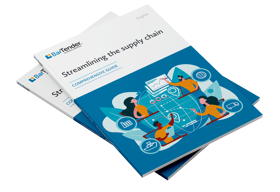E-labeling is a modern alternative to strictly physical labeling that provides web-based product information via electronic screens such as smartphones and computers. Industries are embracing e-labeling for several reasons, including to abide by law mandates, increase efficiency and provide enhanced and expanded product information.
As technology evolves throughout industries, manufacturers, legislators and regulatory bodies must embrace labels such as barcodes that enable access to online information. When transitioning to an e-labeling model, organizations may need to improve internal systems and operations to meet regulatory requirements. Modern labeling solutions allow for improved integration between internal systems and labeling systems, and by following labeling best practices, organizations can benefit from increased capabilities and consumer satisfaction.
What is e-labeling?
E-labeling stands for electronic labeling and is a barcode of any kind (QR, 1D, color) or RFID inlay that links to online information. The digital barcode provides access to more information than can be displayed directly on a product with a physical label. E-labeling is a way to share compliance information electronically on a screen. By scanning the product code with your smartphone or entering the URL into your web browser, you are taken directly to important, regulated product information.
What is GS1 Digital Link?
GS1 Digital Link is an e-labeling standard that enables the dissemination of product data on the web. GS1 Digital Link “web-enables” barcodes by providing a simple, standards-based structure for the data. Before GS1 Digital Link, there was no non-proprietary way for brands to seamlessly communicate with consumers using a barcode scan. Some products carried multiple barcodes which caused scanning issues and consumer confusion. GS1 Digital Link remedied these issues by providing apps, websites and POS scanners with rules they “can use to translate both old and new barcodes into connections, shopping experiences and interesting product content.”
GS1 Digital Link works by using a lookup tool called a “resolver” that functions as an information connector. Depending on the needs of the business and the desired results, resolvers can be developed to manage or connect information in the business-to-consumer context as well as the business-to-business realm. The GS1 Digital Link standard for web-enabled barcodes revolutionizes item-level identification by using a dynamic code that provides contextual data.
Consumers can access information with the simple scan of one code and without the need for a specific app. This single code can produce different results depending on what the point of access is. A consumer can use their smartphone to scan a food product’s QR code that contains a GS1 Digital Link URI and be directed to a brand-owned webpage with additional nutritional details, recipes, and other product information.
This same consumer could scan the exact same barcode using a retailer app and be connected to completely different experiences such as product ordering, brand loyalty points collection and social media product shares.
Pharmaceutical manufacturers are tasked with generating patient information in multiple languages which makes the production of patient leaflets laborious. Instead, consumers could use an app that reads the pharmaceutical product’s GTIN encoded in the GS1 DataMatrix barcode on the package and directs them to an electronic patient information leaflet.
The information is delivered in their preferred language through a simple setting on their smartphone. The app uses the GS1 Digital Link known rules to use the barcode data to connect to an industry-agreed “resolver” service which routes it to the source of the leaflet.
Manufacturers, marketing agencies, logistics and other related parties can leverage GS1 Digital Link and resolver technology to streamline and connect relevant sources of data. Digital Link technology is the future of barcodes and labeling and delivers significant potential throughout global businesses.

What are the benefits of e-labeling?
E-labeling technology can benefit manufacturers, regulators and consumers by connecting and facilitating data-sharing among all participants. Let’s discuss some of the key benefits of e-labeling which span all industries.
Label real estate is limited
E-labeling gives manufacturers the ability to provide more information than they can print on a physical label. This is especially important where label data is regulated, such as in FDA applications like medical devices or pharma manufacturing. The FDA has stated that these online data sources count as an extension of the label and are under FDA purview. This opens the door for detailed and personalized product information that is always current and is not required to fit on the product itself.
Consumers want to know everything about products
Consumers now want to have access to all product particulars, from nutritional information to where a product is from and how ethically it is sourced. By scanning a simple code, they can access things like provenance, nutrition or ingredient information, handling instructions and more. Companies in the food and beverage industry can use e-labeling to share more than just required information. When a consumer scans a code, they may also see a recipe or a coupon. The retail industry can share information consumers need when shopping and making purchasing decisions.
When it comes to healthcare and the pharmaceutical industry, consumers stand to benefit greatly when paper patient information leaflets (PIL) are replaced with e-labeling. Revisions to medicine labels require a lengthy process that results in a newly printed version of the paper document. In addition to this new version, to maintain patient safety, regulations require additional notices to be included with the PIL which are lengthy and difficult to read.
Patient safety is also improved when the pharmaceutical or medical device industries use e-labeling. Electronic labeling allows companies to update safety information immediately and frequently which provides enhanced safety and supports better patient experiences.
In more sophisticated applications, like Digital Link and Amazon Transparency, consumers can find information on the item-level. This means that each item can be individually identified and traced, for example, every package of butter in a pallet or on a shelf.
For brands who want to enroll in the Amazon Transparency program, BarTender includes a labeling solution that includes preconfigured label templates that conform to the branding and application guidelines that the Transparency program requires.
Reduction in production costs and improved supply chain traceability
No matter what industry you are in, when changes are made to a product, product labels must change too. E-labeling offers cost savings in both design manufacturing and in updating compliance information. Rather than having to pay to redesign, retool and print updated labels every time something changes, e-labels are instantaneously updated. There are no physical materials needed and it allows compliance to remain up to date.
As manufacturing trends continue toward interoperability, smart labels provide the foundation for a digital transformation that results in reduced costs and improved supply chain transparency. E-labeling provides information that can be identified by a machine which is increasingly important as global manufacturing lines employ the use of automation. Products can be tracked from end-to-end of the supply chain.
Enables product innovation
Product innovation shouldn’t be held back because of a need for the physical space for a label. E-labeling enables product innovation by removing the challenge of fitting multiple labels onto products. This is especially important in the information and communication technology (ICT) industry where product advancement generally results in reduced size and surface space.
E-labeling also makes it easier for organizations to support multiple iterations of the same product across different markets. E-labeling medical devices is a prime example of such a complex situation. A version-specific IFU must be designated for each product version and content must be regionalized. Online labeling allows companies to effortlessly maintain compliance for each version across locales.
Reduces environmental waste
Physical labeling uses valuable natural resources that could be spared with the use of e-labeling. Consider how many labels are generated only to become environmental waste after a short time. This predicament applies across all industries but is especially poignant in the food and beverage industry where products are one-time use and labeling is relatively large for marketing purposes and to conform to FDA standards.


